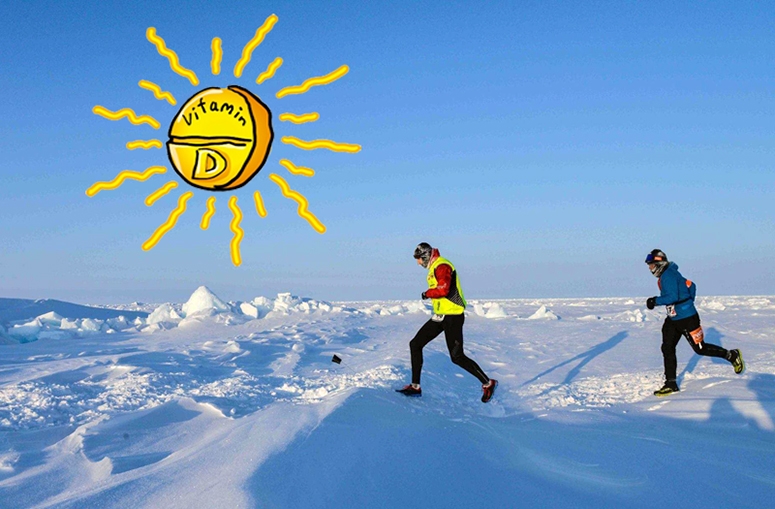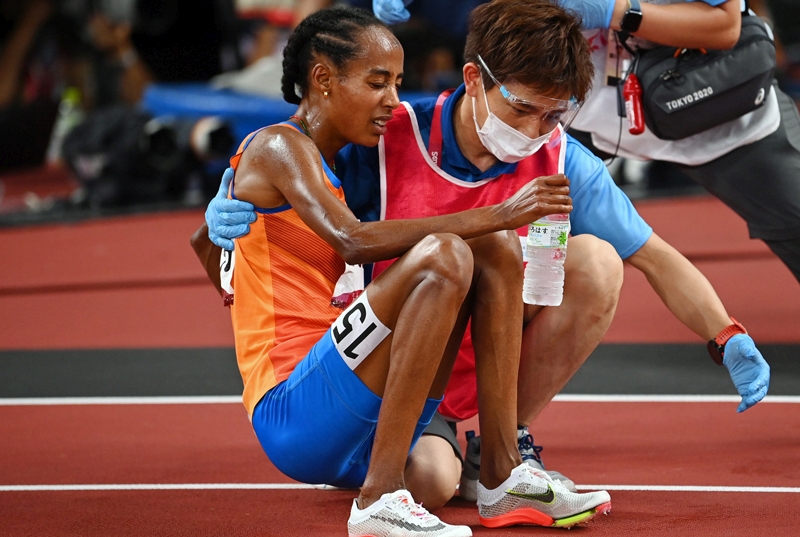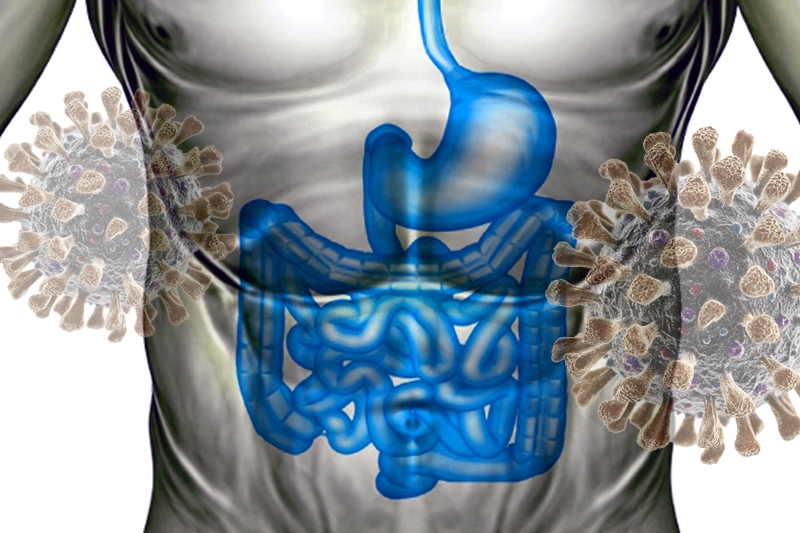You are viewing 1 of your 1 free articles. For unlimited access take a risk-free trial
Exercise recovery: a nutrient that really counts

SPB looks at new research on why optimum vitamin D intakes may be even more crucial for athletes than previously believed
Of all the micronutrients (vitamins and minerals) required for health, none has been researched quite so much recently as vitamin D. This is perhaps not surprising; while traditionally regarded merely as a ‘bone health’ nutrient, more recent research has demonstrated that vitamin D is far more important for optimum human health and performance that previously realised.In a recent SPB article on this topic, we explored why an optimum vitamin D intake is vital for health, why so many athletes fall short of maintaining an optimum vitamin D status and how to ensure this doesn’t happen. Among the more recent research findings on the link between human health and an optimum vitamin D intake are the following:
*Degenerative disease - A growing body of evidence has found that optimum intakes of vitamin D in adults provide significant protection from degenerative diseases such as heart disease, multiple sclerosis and a number of different cancers(1,2).
*Immunity – A growing body of research also suggests that sub-optimum vitamin D status harms immunity, but also that boosting vitamin D intake improves immunity. For example, a poor vitamin D status is linked to a higher incidence of upper respiratory tract infections (coughs, colds, sore throats etc) but increasing vitamin intake, especially over the winter period, reduces the incidence and severity of URTIs(3).
Why is vitamin D implicated in immunity? Well, research shows that vitamin D enhances powerful immune cells known as ‘CD4+ T cells’ – indeed, these cells actually have receptors for vitamin D on their surface(4). Vitamin D also promotes the production of virus-specific antibodies by activating T cell-dependent B cells – ie if infection cannot be halted early by the CD4+ T cells, vitamin D helps the body gear up to mount a more general attack on the virus/bacteria by encouraging the production of B cell antibodies.
Vitamin D and Covid-19
In the light of the Covid-19 pandemic and the role of vitamin D in immunity, it is perhaps unsurprising that having a good vitamin D status seems likely to be a simple and effective way to reduce your risk; multiple observational studies have shown that blood concentrations of vitamin D are inversely correlated with the incidence and/or severity of COVID-19(5). In short, those with an excellent vitamin D status appear less likely to become ill with Covid-19, and where illness does occur, it tends to be less severe with less risk of hospitalization/death. A poor vitamin D status by contrast is strongly associated with an increased likelihood of symptomatic illness, hospitalization and death. (Hint for the coming winter months – optimize your vitamin D intake!)*Injury risk –Vitamin D is needed for the formation of strong, healthy bones, and research clearly shows that sub-optimum intakes of vitamin D can greatly increase the risk of stress fracture in athletes(6). There’s also good evidence that a poor vitamin D status increases the risk of muscle and other soft tissue injuries in athletes – particularly in the lower limbs and core muscles(7).
Vitamin D and exercise performance
A more contentious issue relating to vitamin D is its effect on exercise performance. Some research suggests that performance might be improved in athletes with an optimum vitamin D status(8) and that higher intakes of vitamin D can improve some power and strength measures in athletes(9). However, the evidence on performance is somewhat patchier, and some studies have found no benefits(10,11).One area of research where there is relatively little data is the relationship between vitamin D intake/status and recovery after strenuous exercise. As regular SPB subscribers will know, maximizing and accelerating recovery after exercise using excellent nutrition is a vital part of any successful training plan; the faster and more completely an athlete recovers, the sooner he/she can resume quality training again, which over time maximizes fitness gains for competition (see this article for an in-depth discussion on recovery nutrition).
When training becomes intense however, post-exercise soreness caused by inflammation can become an issue. An excessive inflammatory response induced by exercise is thought to be one of the essential factors that limit sports performance. This happens when excessive pro-inflammatory ‘cytokines’ (basically molecules that enable your body’s cells to communicate with each other and which are essential for healthy immune function) impair the metabolism of skeletal muscle and other tissues, and induce inflammation of the central nervous system. This in turn leads to the altered movement patterns, coordination loss, and soreness due to general inflammation(12). Some athletes resort to post-exercise anti-inflammatory medication such as Ibuprofen to combat soreness(13). However, this is not recommended; not only are there hazards when using non-steroidal anti-inflammatory (NSAID) on a chronic basis (see this article), research shows that NSAIDs do not actually protect against exercise induced muscle damage(14).
Pre-exercise vitamin D as an anti-inflammatory
Could there be a better anti-inflammatory alternative in the form of vitamin D? Many studies suggest that vitamin D plays an anti-inflammatory role in the body(15), and it is known that the active form of vitamin D regulates the expression of approximately 1000 genes, including those that are responsible for the production of pro-inflammatory cytokines(16). Moreover, animal models show that inflammation induced by high-intensity exercise is significantly reduced by vitamin D supplementation(17).Given the above, new research published in the journal ‘Nutrients’ has investigated the effects of giving a large one-off pre-exercise dose of vitamin D on post-exercise inflammation in ultramarathon runners(18). In this study – a rigorous double-blind randomized controlled trial – researchers analyzed the effect of a single, pre-exercise high-dose vitamin D supplementation on the inflammatory marker levels in ultramarathon runners after an ultramarathon run (maximal run 240 km). Thirty five runners (amateurs) were assigned into two groups:
- A single high-dose vitamin D supplementation group who took vitamin D (150,000 IU) in vegetable oil 24 hours before the start of the run.
- A placebo group who took vegetable oil matched for taste and consistency but with no vitamin D in it.
The findings
The blood levels of vitamin D rose significantly in both groups of runners following the run. This was not unexpected as previous research has shown that during strenuous exercise, a portion of the body’s stores of vitamin D is liberated into the blood – possibly as a mechanism to curb inflammation and support immune function(19). However, vitamin D levels rose to significantly higher levels in supplemented runners compared to the placebo group (suggesting they had more reserves to release during exercise). At 24 hours post the ultramarathon run, the vitamin D group averaged vitamin D blood levels of 67.93ng/ml compared to 49.54ng/ml in the placebo group. Importantly, the increase in pro-inflammatory interleukin 6 and 10 levels immediately after the run was significantly higher in runners in the control group than that in those in the supplementation group – ie the runners who didn’t take vitamin D experienced higher levels of inflammation than the vitamin D supplemented runners.Figure 1: Levels of pro-inflammatory IL-6 and IL-10(18)

Graphs show blood levels in pictograms per ml of IL-6 (left) and IL-10 (right) before the run (I), immediately after (II) and 24 hours later (III). Red = placebo runners; green = vitamin D supplemented runners.
Practical implications
The authors of this study concluded that their study clearly demonstrated that the inflammatory response induced by a very demanding exercise load such as ultramarathon running is significantly blunted in athletes who had received a single high dose of vitamin D before the run. The practical implications flowing from these findings are threefold:- Athletes with a optimum vitamin D status have greater vitamin D ‘reserves’ to draw upon when undertaking a demanding event, which may enable them to mount a superior anti-inflammatory response.
- Maintaining an optimum vitamin D status at all times may therefore be a wise strategy to reduce exercise-induced inflammation and so promote faster recovery.
- For exceptional events such as an ultra-endurance competition, an additional high-dose bolus of vitamin D (150,000IU is around 30 times the maximum daily recommended vitamin D intake) may provide additional benefits.
- Try to consume plenty of vitamin D-rich foods (oily fish, eggs and vitamin D-fortified produce) at all times of the year.
- To confirm your vitamin D status, considered getting it checked – either through your physician or using a home blood-testing kit.
- If your blood level is below 75nmol/L, consider supplementing with 2000-5000IU of vitamin D3 (not D2) per day until your status is improved – regardless of season.
- During the summer months, try to regularly expose your skin to some strong sunshine for 15-20 minutes before covering up or applying sunscreen/sun block. Regular sun exposure can help build up your body’s vitamin D stores in readiness for the winter months ahead.
- In winter, consider a break nearer to the equator to boost your flagging vitamin D levels!
- Use the ‘sunshine zone’ map (figure 2) to determine when vitamin D supplementation should be considered.
Figure 2 Sunshine, season, latitude and vitamin D synthesis

NB: North America given as an example, but recommendations based on latitude apply regardless of location.
References
- Mol Nutr Food Res. 2010 Aug;54(8):1164-71
- BMJ 2014;348:g1903
- J Nutr Health Aging. 2018;22(4):491-500
- Int J Mol Sci. 2021 May 16;22(10):5251
- Int J Mol Sci. 2021 May 16;22(10):5251
- PM R. (2010) 2:945–949
- Arthroscopy. 2018 Apr;34(4):1280-1285
- Int J Environ Res Public Health. 2018 Dec 3;15(12). pii: E2724
- Int J Environ Res Public Health. 2019 Sep 14;16(18). pii: E3422
- PLoS One. 2018 Apr 9;13(4):e0195284
- Nutrients. 2019 Aug 21;11(9). pii: E1960
- Am. J. Physiol.-Regul. Integr. Comp. Physiol. 2006;291:R1344–R1348
- Brain Behav. Immun. 2006;20:578–584
- Med. Sci. Sports Exerc. 2003;35:892–896
- J. Inflamm. Res. 2014;7:69–87
- Curr. Nutr. Rep. 2020;9:226–235
- Cytokine. 2013;63:27–35
- Nutrients. 2021 Apr; 13(4): 1280
- J. Clin. Endocrinol. Metab. 2017;102:3937–3944
- Nutrients. 2016 Sep; 8(9): 533
Newsletter Sign Up
Testimonials
Dr. Alexandra Fandetti-Robin, Back & Body Chiropractic
Elspeth Cowell MSCh DpodM SRCh HCPC reg
William Hunter, Nuffield Health
Newsletter Sign Up
Coaches Testimonials
Dr. Alexandra Fandetti-Robin, Back & Body Chiropractic
Elspeth Cowell MSCh DpodM SRCh HCPC reg
William Hunter, Nuffield Health
Keep up with latest sports science research and apply it to maximize performance
Today you have the chance to join a group of athletes, and sports coaches/trainers who all have something special in common...
They use the latest research to improve performance for themselves and their clients - both athletes and sports teams - with help from global specialists in the fields of sports science, sports medicine and sports psychology.
They do this by reading Sports Performance Bulletin, an easy-to-digest but serious-minded journal dedicated to high performance sports. SPB offers a wealth of information and insight into the latest research, in an easily-accessible and understood format, along with a wealth of practical recommendations.
*includes 3 coaching manuals
Get Inspired
All the latest techniques and approaches
Sports Performance Bulletin helps dedicated endurance athletes improve their performance. Sense-checking the latest sports science research, and sourcing evidence and case studies to support findings, Sports Performance Bulletin turns proven insights into easily digestible practical advice. Supporting athletes, coaches and professionals who wish to ensure their guidance and programmes are kept right up to date and based on credible science.











